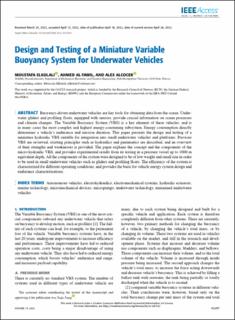| dc.contributor.author | Elkolali, Moustafa | |
| dc.contributor.author | Al-Tawil, Ahmed | |
| dc.contributor.author | Alcocer, Alex | |
| dc.date.accessioned | 2022-12-09T09:26:45Z | |
| dc.date.available | 2022-12-09T09:26:45Z | |
| dc.date.created | 2022-09-22T13:29:06Z | |
| dc.date.issued | 2022-04-18 | |
| dc.identifier.citation | IEEE Access. 2022, 10 42297-42308. | en_US |
| dc.identifier.issn | 2169-3536 | |
| dc.identifier.uri | https://hdl.handle.net/11250/3036938 | |
| dc.description.abstract | Buoyancy-driven underwater vehicles are key tools for obtaining data from the ocean. Underwater gliders and profiling floats, equipped with sensors, provide crucial information on ocean processes and climate changes. The Variable Buoyancy System (VBS) is a key element of these vehicles, and is in many cases the most complex and highest energy-consuming subsystem. Energy consumption directly determines a vehicle’s endurance and mission duration. This paper presents the design and testing of a miniature hydraulic VBS suitable for integration into small underwater vehicles and platforms. Previous VBS are reviewed, existing principles such as hydraulics and pneumatics are described, and an overview of their strengths and weaknesses is provided. The paper explains the concept and the components of the micro-hydraulic VBS, and provides experimental results from its testing in a pressure vessel up to 1000 m equivalent depth. All the components of the system were designed to be of low weight and small size in order to be used in small underwater vehicles such as gliders and profiling floats. The efficiency of the system is characterized for different operating conditions, and provides the basis for vehicle energy system design and endurance characterizations. | en_US |
| dc.description.sponsorship | This work was supported by the OASYS research project, which is funded by the Research Council of Norway (RCN), the German Federal Ministry of Economic Affairs and Energy (BMWi) and the European Commission under the framework of the ERA-NET Cofund MarTERA. | en_US |
| dc.language.iso | eng | en_US |
| dc.publisher | Institute of Electrical and Electronics Engineers | en_US |
| dc.relation.ispartofseries | IEEE Access;Volume 10, 2022 | |
| dc.rights | Attribution-NonCommercial-NoDerivatives 4.0 Internasjonal | * |
| dc.rights.uri | http://creativecommons.org/licenses/by-nc-nd/4.0/deed.no | * |
| dc.subject | Autonomous vehicles | en_US |
| dc.subject | Electrohydraulics | en_US |
| dc.subject | Electromechanical systems | en_US |
| dc.subject | Hydraulic actuators | en_US |
| dc.subject | Marine technology | en_US |
| dc.subject | Micromechanical devices | en_US |
| dc.subject | Unmanned underwater vehicles | en_US |
| dc.title | Design and Testing of a Miniature Variable Buoyancy System for Underwater Vehicles | en_US |
| dc.type | Peer reviewed | en_US |
| dc.type | Journal article | en_US |
| dc.description.version | publishedVersion | en_US |
| cristin.ispublished | true | |
| cristin.fulltext | original | |
| cristin.qualitycode | 1 | |
| dc.identifier.doi | https://doi.org/10.1109/ACCESS.2022.3167833 | |
| dc.identifier.cristin | 2054351 | |
| dc.source.journal | IEEE Access | en_US |
| dc.source.volume | 10 | en_US |
| dc.source.issue | 10 | en_US |
| dc.source.pagenumber | 42297-42308 | en_US |
| dc.relation.project | Norges forskningsråd: 284477 | en_US |

